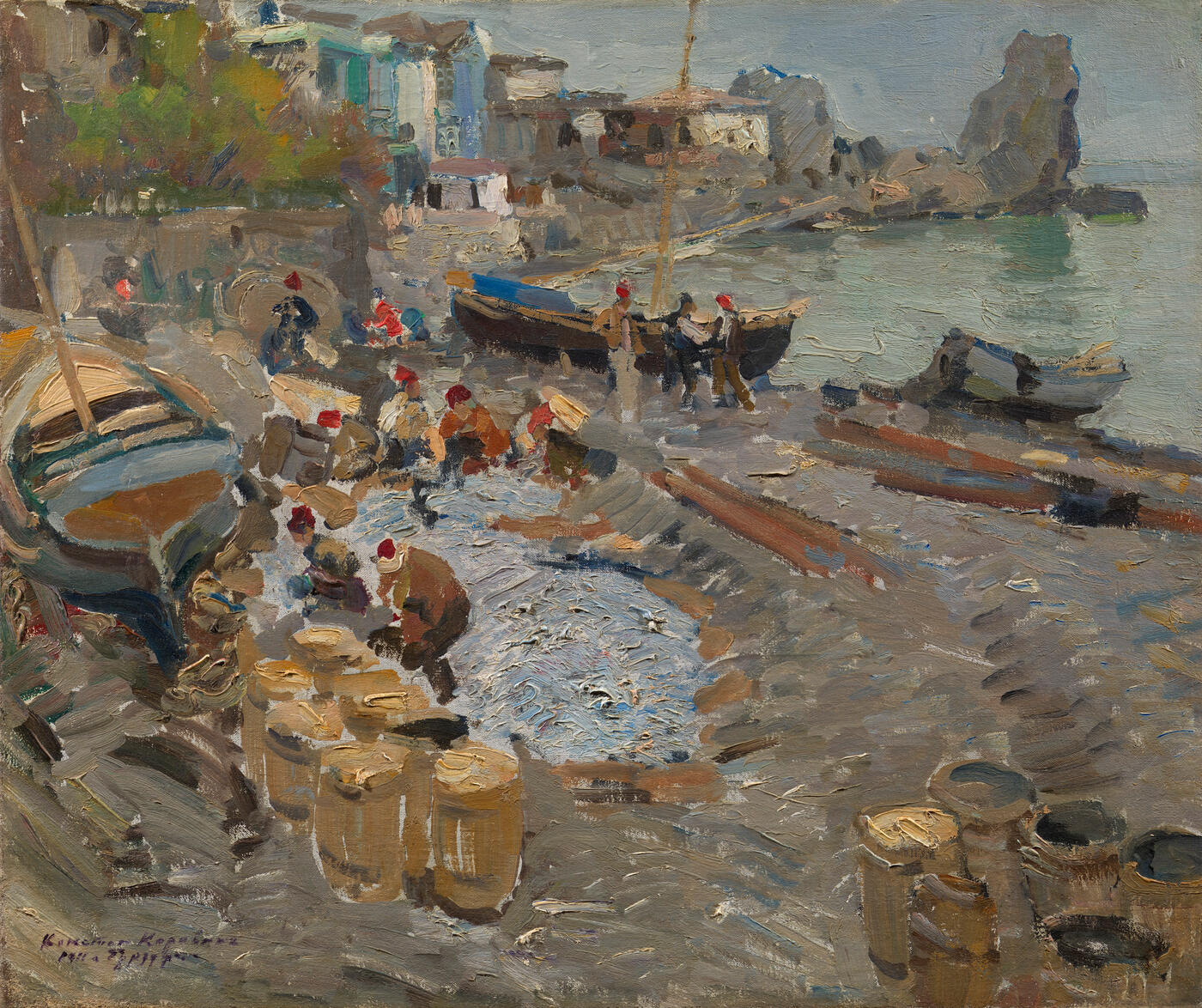28 Nov 2018 Important Russian Art Auctions, at Asia House
28 November 2018

* 7. KOROVIN, KONSTANTIN (1861–1939)
Fishing Boats, Gurzuf, signed, inscribed in Cyrillic "Gurzuf" and dated 1911.
Oil on canvas, 54.5 by 65 cm.
140,000-180,000 GBP
Provenance: Acquired directly from the artist by Ekaterina Geltser (1876–1962), a renowned ballet dancer.
Thence by descent.
Collection of Tatiana Geltser, sister of the above.
Russian Paintings and Works of Art, Christie’s London, 15 December 2000, lot 41.
Authenticity of the work has been confirmed by the expert V. Petrov.
Exhibited: Konstantin Korovin. 1861–1939. K stoletiiu so dnia rozhdeniia, Academy of Arts of the USSR, Moscow, 1961.
Literature: Exhibition catalogue, Konstantin Korovin. 1861–1939. K stoletiiu so dnia rozhdeniia, Moscow, Izdatelstvo Akademii khudozhestv SSSR, 1961, p. 35, listed.
Exhibition catalogue, Geltser. Kollektsiia, Moscow, Galereia Nashi Khudozniki, 2017, p. 154, included as Gurzuf in the list of works known from publications and archival sources.
Konstantin Korovin’s picture Fishing Boats, Gurzuf was painted in the spring of 1911, during the first and most inspired period of the artist’s life in his Crimean dacha. Korovin later recalled this time with nostalgia: “In Gurzuf, I built myself a fourteen-room house by the sea. It was a good house. When you woke up, you could see roses from the balcony and a blue sea.... The Adalars were visible from the terrace — two large rocks protruding from the sea, ‘the desolate rocks’. Nobody lived on those rocks. Only swifts would dart back and forth. There was neither water nor vegetation there” (Konstantin Korovin vspominaet ..., Moscow, Izobrazitelnoe iskusstvo, 1990, p. 106). It is this view, opening out from the terrace over the curve of the coastline and culminating in a solitary cliff or the Adalar rocks standing a little further away, that was to become the classic “background” for Korovin’s Crimean landscapes, portraits and still lifes, which account for his fame as a painter today.
In all likelihood, the landscape to be auctioned is one of the studies that Korovin produced one afternoon when, following his usual habit, he was going down from the balcony towards the sea in search of a suitable outdoor setting. This time, he chooses his same favourite spot on the coast, but he does not look at it from the terrace, lined with bunches of roses and tubs planted with oleanders, but from the steps leading down to the quayside, which allows the artist to keep a high vantage point for the viewer, but at the same time opens up a wider coastline panorama and permits the viewer to take in the unfolding picture of everyday life for fishermen in a small seaside town.
As he depicts people bustling around their boats, as well as buildings and rocks against the background of an opaque, whitish sea, viscous and damp coastal sand after a recent rainfall, and logs and fish barrels lined up in rows, the artist displays real painting skill, the energy of his vigorous brush movements, the abundance of forms taken on by his grey-brown brushstrokes, similar in tone, that sometimes “darn” the canvas diagonally in an overlapping manner and, at other times, settle down into even, parallel strokes. For Korovin, painting is more important than subject matter, and it is virtually impossible to grasp the difference between a brushstroke and the object depicted by it in the overall chaos of colours.
The artist, constantly inspired by his favourite corner of the Gurzuf quayside, was able to pass on his optimistic love to his friends too. In his memoirs, he recalled that Feodor Chaliapin, who once visited the dacha in Gurzuf, was so overwhelmed by the view that opened out onto the solitary, grey, stony cliff at the end of the shoreline that he actually decided to buy it so as to build a villa there. Although Chaliapin really did purchase the cliff, the plan was never carried out because of the revolution, but the gloomy rock, clearly visible in most Gurzuf landscapes, as well as in the presented painting, has been named after Chaliapin.
The Gurzuf views enjoyed an enduring popularity among the artist’s admirers. Accordingly, the canvas now to be auctioned comes from the celebrated collection of the Bolshoi Theatre ballerina Ekaterina Geltser, who knew Korovin personally and was a friend of his. The Gurzuf Bay landscape was purchased by Geltser from Korovin or given by the artist to the ballerina, whose collection included other works by him. After the death of Geltser and her heirs, part of the ballerina’s extensive collection of Russian paintings ended up in the State Tretyakov Gallery, the Bakhrushin State Central Theatre Museum and the Glinka Russian National Museum of Music, while the rest was dispersed among private collections. Works from Geltser’s collection appear very rarely on the art market, so the offer for sale at MacDougall’s of Korovin’s painting Fishing Boats, Gurzuf, which is of exceptional quality and has such a glittering provenance, is an event of outstanding importance.
Notes on symbols:
* Indicates 5% Import Duty Charge applies.
Ω Indicates 20% Import Duty Charge applies.
§ Indicates Artist's Resale Right applies.
† Indicates Standard VAT scheme applies, and the rate of 20% VAT will be charged on both hammer price and premium.